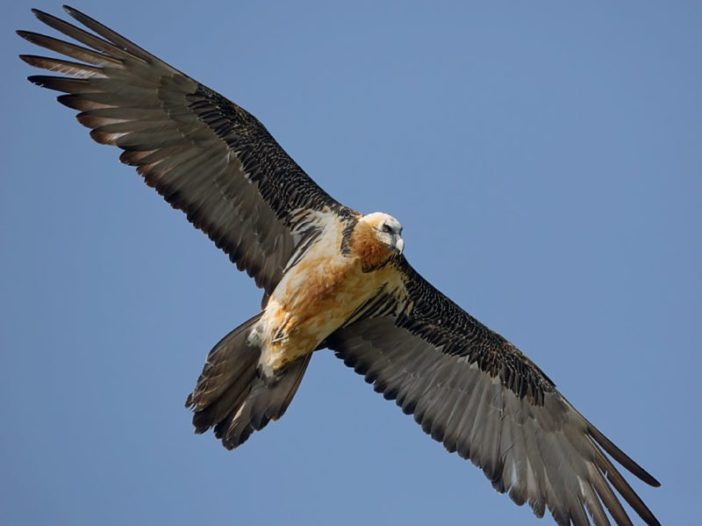
There are three types of vultures in the French Alps.? These are:
- The Bearded Vulture or Lammergeier (French: Gypaete Barbu; Latin: Gypaetus barbatus )
- The Griffon vulture (French: Vautour fauvre; Latin: Gyps fulvus )
- The Eurasian Black Vulture or Cinereous Vulture (Latin: Aegypius monachus; French: Vautour Moine)
The Bearded Vulture
Concerning the Gypaete Barbu, as of 2013 there were nine breeding pairs in the French Alps seven of which are resident in Savoie & Haute Savoie.? Overall in the Alpine ?Arc? there are just twenty-seven breeding couples; so the French Alps do quite well here!
This makes me realise quite how fortunate I am to see this magnificent bird on a regular basis.? During this last winter almost each time I’ve gone to area of Champagny-le-Haut I’ve had a sighting of the gypaete.? On one occasion it ?performed? for about five minutes, soaring effortlessly along the south-facing slopes of the valley looking for its next meal.? The other area where I’ve observed the vulture is leading up to the Col de la Vanoise from Pralognan-la-Vanoise.
The gypaete had completely disappeared from the Alps at the beginning of the 20th century.? Today, even though there is some optimism it remains one of the most threatened in Europe.? This despite an introduction programme that has gone on for 30 years.
The Gypaete lives for about 30 years.? After 6 years its chances of survival approach 95%.? It doesn’t reproduce until it reaches 8 years old and produces on average 1 off-spring every 3 years.? So the rate of population growth is extremely slow and any disturbance causing a reduction in this rate has a marked affect on the species rate of growth.? An interesting fact to note is that vultures return to the place they first flew.? Vultures fitted with gps trackers have been logged flying from the Vanoise to Austria, back via Italy and then heading as far as Madrid in Spain before coming back stopping off in the Cevennes!? An impressive journey.
The gypaete is a very curious bird and it’s not rare to see it approach man.? At the same time it’s fearful and sensitive notably in the proximity to it’s nesting area.? The ?Le Projet LIFE Gyphelp? is not about trying to ban everything but about finding a way to reconcile human activities and the tranquility of the species.
Threats to the vultures
The greatest risk to vultures include: poisoning, collisions with overhead cables and disturbance.
Poisoning is not necessarily deliberate.? Sometimes it is as a result of the vultures eating the carcases of dead farm animals that have been given drugs by vets.? The anti-inflammatory drug ?Diclofenac? is fatal to vultures.? Another source of poisoning is the ingestion of lead fragments from animals killed by hunters.? The lead in animal remains is ingested by the bird and given the extreme ph value of the gypaetes gastric juices (around ph 2) the lead is dissolved.? This then enters the blood stream and bird ends up dying from lead poisoning.
Collisions from overhead cables in the form of electicity cables or ski lift cables is known to have been the cause of death of a number of birds.? Thanks to the action of the ?Projet LIFE GypHelp? the more critical cables have been fitted with warning markers that has decreased the fatality level for birds and not just the vulture.
Human disturbance to vultures, particularly when nesting, can cause the birds to abandon the nest and its eggs or young off-spring.? These disturbances can be the result of a range of outdoor activities and photography.? One breeding pair were disturbed by ?speed riders? (a small paraglider with the person on skis) near Peisey-Nancroix and they deserted the nest with a young bird that subsequently died.? The people involved have been prosecuted in the courts.
You can find out more on the following sites.


